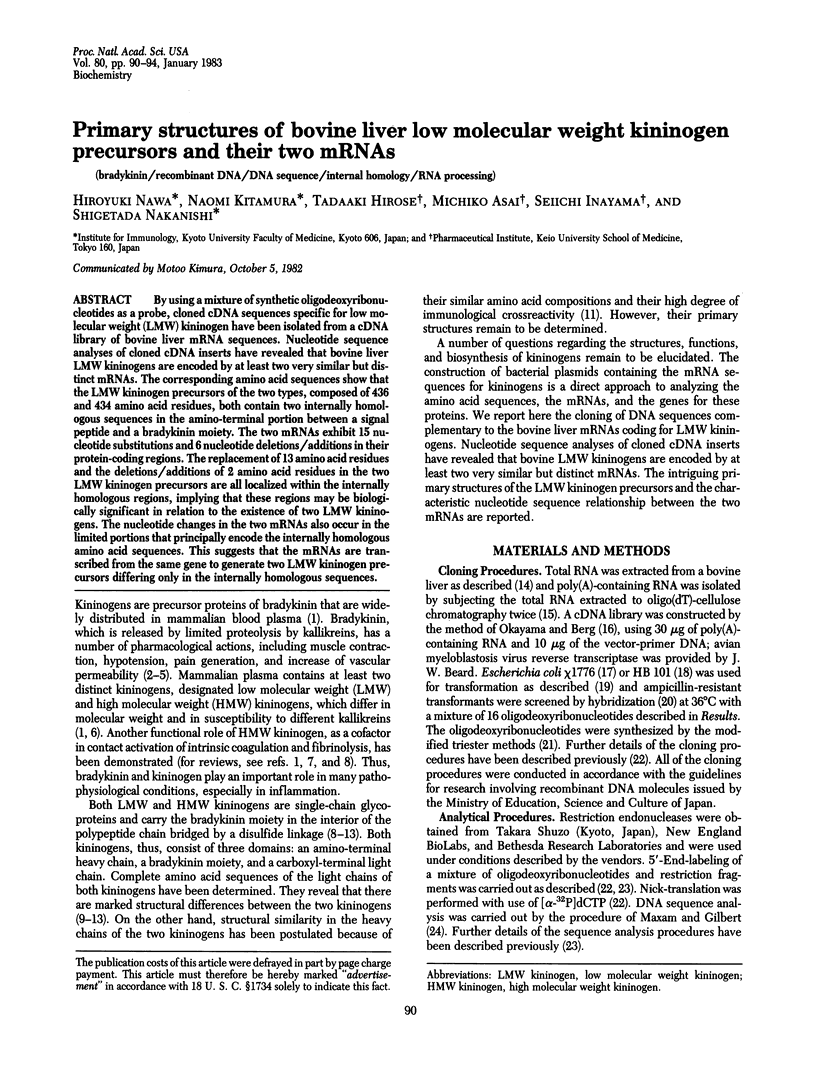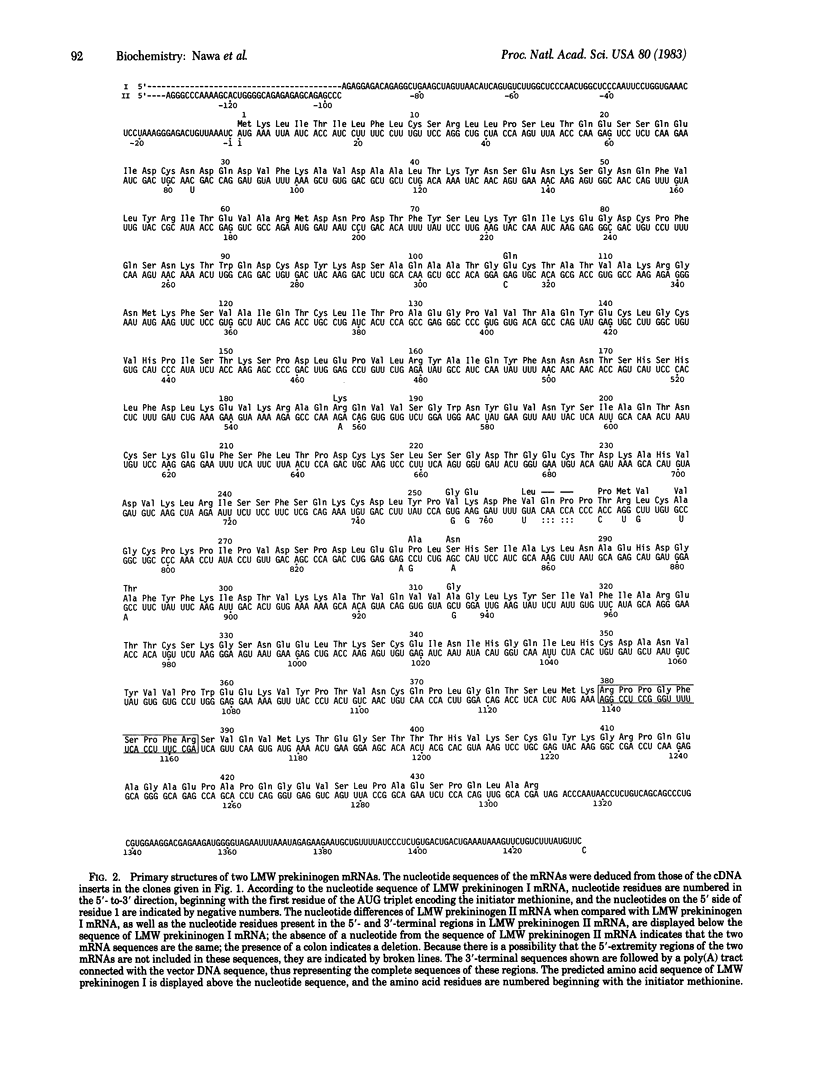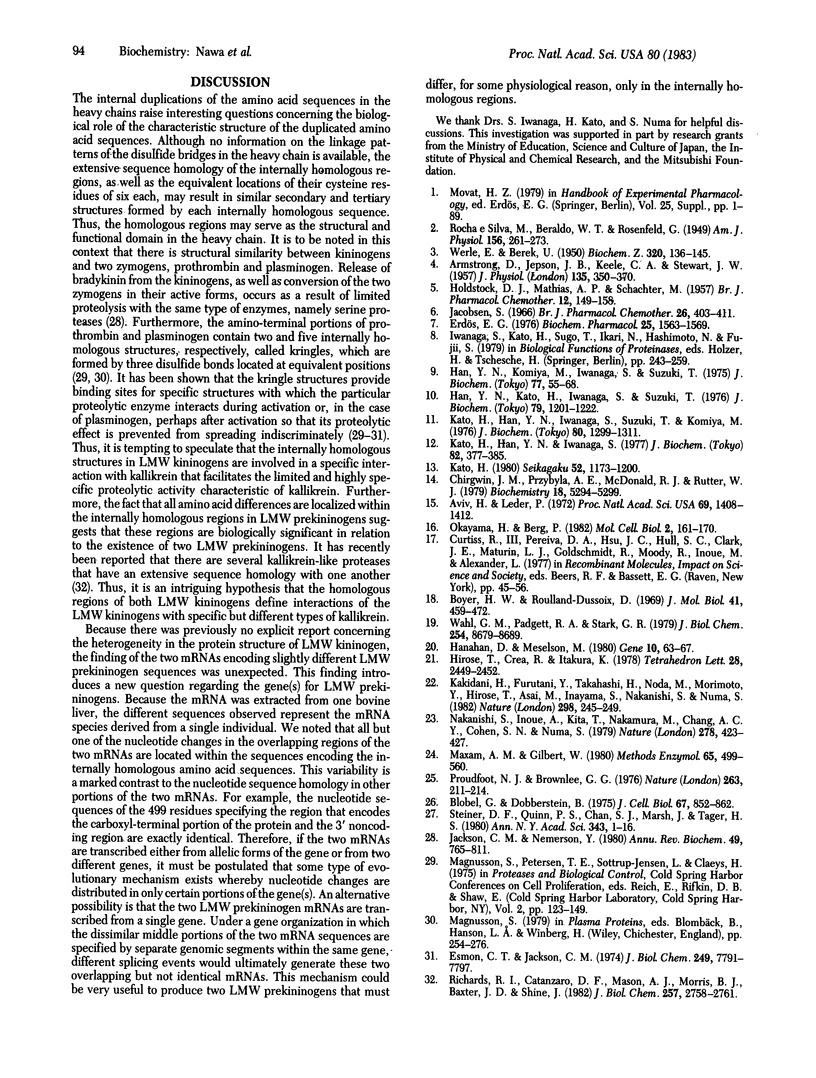Abstract
By using a mixture of synthetic oligodeoxyribonucleotides as a probe, cloned cDNA sequences specific for low molecular weight (LMW) kininogen have been isolated from a cDNA library of bovine liver mRNA sequences. Nucleotide sequence analyses of cloned cDNA inserts have revealed that bovine liver LMW kininogens are encoded by at least two very similar but distinct mRNAs. The corresponding amino acid sequences show that the LMW kininogen precursors of the two types, composed of 436 and 434 amino acid residues, both contain two internally homologous sequences in the amino-terminal portion between a signal peptide and a bradykinin moiety. The two mRNAs exhibit 15 nucleotide substitutions and 6 nucleotide deletions/additions in their protein-coding regions. The replacement of 13 amino acid residues and the deletions/additions of 2 amino acid residues in the two LMW kininogen precursors are all localized within the internally homologous regions, implying that these regions may be biologically significant in relation to the existence of two LMW kininogens. The nucleotide changes in the two mRNAs also occur in the limited portions that principally encode the internally homologous amino acid sequences. This suggests that the mRNAs are transcribed from the same gene to generate two LMW kininogen precursors differing only in the internally homologous sequences.
Full text
PDF




Images in this article
Selected References
These references are in PubMed. This may not be the complete list of references from this article.
- ARMSTRONG D., JEPSON J. B., KEELE C. A., STEWART J. W. Pain-producing substance in human inflammatory exudates and plasma. J Physiol. 1957 Feb 15;135(2):350–370. doi: 10.1113/jphysiol.1957.sp005715. [DOI] [PMC free article] [PubMed] [Google Scholar]
- Aviv H., Leder P. Purification of biologically active globin messenger RNA by chromatography on oligothymidylic acid-cellulose. Proc Natl Acad Sci U S A. 1972 Jun;69(6):1408–1412. doi: 10.1073/pnas.69.6.1408. [DOI] [PMC free article] [PubMed] [Google Scholar]
- Blobel G., Dobberstein B. Transfer of proteins across membranes. II. Reconstitution of functional rough microsomes from heterologous components. J Cell Biol. 1975 Dec;67(3):852–862. doi: 10.1083/jcb.67.3.852. [DOI] [PMC free article] [PubMed] [Google Scholar]
- Boyer H. W., Roulland-Dussoix D. A complementation analysis of the restriction and modification of DNA in Escherichia coli. J Mol Biol. 1969 May 14;41(3):459–472. doi: 10.1016/0022-2836(69)90288-5. [DOI] [PubMed] [Google Scholar]
- Chirgwin J. M., Przybyla A. E., MacDonald R. J., Rutter W. J. Isolation of biologically active ribonucleic acid from sources enriched in ribonuclease. Biochemistry. 1979 Nov 27;18(24):5294–5299. doi: 10.1021/bi00591a005. [DOI] [PubMed] [Google Scholar]
- Esmon C. T., Jackson C. M. The conversion of prothrombin to thrombin. IV. The function of the fragment 2 region during activation in the presence of factor V. J Biol Chem. 1974 Dec 25;249(24):7791–7797. [PubMed] [Google Scholar]
- HOLDSTOCK D. J., MATHIAS A. P., SCHACHTER M. A comparative study of kinin, kallidin, and bradykinin. Br J Pharmacol Chemother. 1957 Jun;12(2):149–158. doi: 10.1111/j.1476-5381.1957.tb00113.x. [DOI] [PMC free article] [PubMed] [Google Scholar]
- Han Y. N., Kato H., Iwanaga S., Suzuki T. Primary structure of bovine plasma high-molecular-weight kininogen. The amino acid sequence of a glycopeptide portion (fragment 1) following the C-terminus ot the bradykinin moiety. J Biochem. 1976 Jun;79(6):1201–1222. doi: 10.1093/oxfordjournals.jbchem.a131175. [DOI] [PubMed] [Google Scholar]
- Han Y. N., Komiya M., Iwanaga S., Suzuki T. Studies on the primary structure of bovine high-molecular-weight kininogen. Amino acid sequence of a fragment ("histidine-rich peptide") released by plasma kallikrein. J Biochem. 1975 Jan 1;77(1?):55–68. [PubMed] [Google Scholar]
- Hanahan D., Meselson M. Plasmid screening at high colony density. Gene. 1980 Jun;10(1):63–67. doi: 10.1016/0378-1119(80)90144-4. [DOI] [PubMed] [Google Scholar]
- Jackson C. M., Nemerson Y. Blood coagulation. Annu Rev Biochem. 1980;49:765–811. doi: 10.1146/annurev.bi.49.070180.004001. [DOI] [PubMed] [Google Scholar]
- Jacobsen S. Substrates for plasma kinin-forming enzymes in human, dog and rabbit plasmas. Br J Pharmacol Chemother. 1966 Feb;26(2):403–411. doi: 10.1111/j.1476-5381.1966.tb01920.x. [DOI] [PMC free article] [PubMed] [Google Scholar]
- Kakidani H., Furutani Y., Takahashi H., Noda M., Morimoto Y., Hirose T., Asai M., Inayama S., Nakanishi S., Numa S. Cloning and sequence analysis of cDNA for porcine beta-neo-endorphin/dynorphin precursor. Nature. 1982 Jul 15;298(5871):245–249. doi: 10.1038/298245a0. [DOI] [PubMed] [Google Scholar]
- Kato H., HAN Y. N., Iwanaga S. Primary structure of bovine plasma low-molecular-weight kininogen. The complete amino acid sequence of COOH-terminal portion following the bradykinin moiety. J Biochem. 1977 Aug;82(2):377–385. [PubMed] [Google Scholar]
- Kato H., Han Y. N., Iwanaga S., Suzuki T., Komiya M. Bovine plasma HMW and LMW kininogens. Structural differences between heavy and light chains derived from the kinin-free proteins. J Biochem. 1976 Dec;80(6):1299–1311. doi: 10.1093/oxfordjournals.jbchem.a131402. [DOI] [PubMed] [Google Scholar]
- Kato H. [Initiation mechanism of intrinsic blood coagulation: activation of factor XII and roles of high-molecular-weight kininogen (author's transl)]. Seikagaku. 1980 Nov;52(11):1173–1200. [PubMed] [Google Scholar]
- Maxam A. M., Gilbert W. Sequencing end-labeled DNA with base-specific chemical cleavages. Methods Enzymol. 1980;65(1):499–560. doi: 10.1016/s0076-6879(80)65059-9. [DOI] [PubMed] [Google Scholar]
- Nakanishi S., Inoue A., Kita T., Nakamura M., Chang A. C., Cohen S. N., Numa S. Nucleotide sequence of cloned cDNA for bovine corticotropin-beta-lipotropin precursor. Nature. 1979 Mar 29;278(5703):423–427. doi: 10.1038/278423a0. [DOI] [PubMed] [Google Scholar]
- Okayama H., Berg P. High-efficiency cloning of full-length cDNA. Mol Cell Biol. 1982 Feb;2(2):161–170. doi: 10.1128/mcb.2.2.161. [DOI] [PMC free article] [PubMed] [Google Scholar]
- Proudfoot N. J., Brownlee G. G. 3' non-coding region sequences in eukaryotic messenger RNA. Nature. 1976 Sep 16;263(5574):211–214. doi: 10.1038/263211a0. [DOI] [PubMed] [Google Scholar]
- Richards R. I., Catanzaro D. F., Mason A. J., Morris B. J., Baxter J. D., Shine J. Mouse glandular kallikrein genes. Nucleotide sequence of cloned cDNA coding for a member of the kallikrein arginyl esteropeptidase group of serine proteases. J Biol Chem. 1982 Mar 25;257(6):2758–2761. [PubMed] [Google Scholar]
- Steiner D. F., Quinn P. S., Chan S. J., Marsh J., Tager H. S. Processing mechanisms in the biosynthesis of proteins. Ann N Y Acad Sci. 1980;343:1–16. doi: 10.1111/j.1749-6632.1980.tb47238.x. [DOI] [PubMed] [Google Scholar]
- Wahl G. M., Padgett R. A., Stark G. R. Gene amplification causes overproduction of the first three enzymes of UMP synthesis in N-(phosphonacetyl)-L-aspartate-resistant hamster cells. J Biol Chem. 1979 Sep 10;254(17):8679–8689. [PubMed] [Google Scholar]



